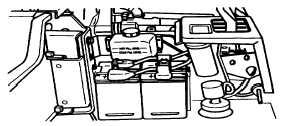| |
TM 10-3930-671-24
Engine Coolant Specification
Refer to Section 2. 1, Service Specifications, Cooling
System.
NOTE
•
For maximum cooling efficiency,
always keep the cooling system
filled with the recommended coolant
mixture year around and at all
ambient temperatures.
•
The use only of an antifreeze having
a low-silicate additive content is
strongly recommended. Silicates
are added to antifreeze to help
protect aluminum cylinder heads in
automotive engines. During use, the
silicate additives may react to form
gummy deposits that can block and
seriously damage a cooling system.
Low-silicate antifreeze is available
for heavy duty use. Also, some tap
waters react adversely with coolant
chemicals. If your local tap water is
"hard," use distilled water.
•
The cooling system is initially filled
with a factory installed solution of
50% water and 50% permanent type
antifreeze
containing
rust
and
corrosion inhibitors. You should
leave it in year around. Plain water
may be used only in an emergency,
but replace it with the specified
coolant as soon as possible to avoid
damage to the system or engine.
With only water in the system, do
not let the engine run hot.
•
DO
NOT
USE
ALCOHOL
OR
METHANOL ANTIFREEZE.
Add to or fill radiator only with recommended coolant
mixture of 50% water and 50% low-silicate ethylene
glycol permanent-type antifreeze containing rust and
corrosion inhibitors.
Engine Coolant Level Check
WARNING
Do not remove the radiator cap when
the radiator is hot. Steam or hot
coolant from the radiator can cause
severe burns. Never remove the
radiator cap while the engine is
running. Stop the engine and wait
until it has cooled.
Remove the radiator cap only with
engine stopped and when engine is
cold.
NOTE
Fork lift truck applications require also
checking the coolant level directly in
the radiator. Lift truck radiators will
plug-up and overheat which will force
coolant into overflow reservoir and on
out at the cap. This results in a low
coolant
level
which
exposes
the
transmission
oil
cooler
causing
engine/transaxle overheating.
1.
The coolant level should be at the "COLD" level
line on coolant recovery bottle when engine is
cold.
2.
Coolant level in the radiator should also be
checked at lease once a day (or every 8 hours of
operation) to make sure radiator is 100% full at
all times.
3.
First, turn the cap slowly to release any pressure
that may be in the radiator. Then, push the cap
fully down and turn to release and remove the
cap.
General Procedures
NOTE
If coolant has to be added more than
once a month or if you have to add
more than one quart at a time, check
the cooling system for leaks, or other
reasons,
e.g.
cooling
system
overheating. See below.
Open vent (petcock) on water pump when filling cooling
system.
1.
If coolant level in the radiator or overflow
reservoir is low, add a 50/50 mixture of specified
coolant and water to the correct fill level.
2.
If the cooling system requires the addition of a
large quantity of coolant, and the engine has
been overheating:
a)
Inspect radiator for blockage of air flow
through the fins. Air clean the radiator.
b)
Check the tailpipe. Be sure exhaust flow is
not blowing into the radiator.
c)
Check fan belt and cooling fan drive control
(as applicable).
d)
Check and be sure fan is not installed
backwards (a common problem).
F-94
|

